A leg workout
Movements from Feldenkrais-inspired lessons, repurposed to be strengthening exercises for a workout, to strengthen the muscles that hold the legs together (including the knees), and to increase agility and mobility.
kneesstrengthhip-jointssquatsfeetUP8supinekneelingstanding leg_workout_1

Stand upright with straight legs, with your feet flat on the floor.
Toe raises
Lift your toes only, not the forefoot.
- Variation 1) Lift only big toes, keep other toes on the floor, vice versa.
Variation 2) Change starting position: place forfoot to point in different directions.
Toe raises
Lift your toes only, not the forefoot.

Stand upright with straight legs, with your feet flat on the floor.
Tibial toe raises
Lift your toes and forefoot, make a tapping sound when hitting the foot back down to the floor.
- Variation 1) Alternate one foot and the other, or lift and tap down both forefeet at the same time
Variation 2) Think of and lead with the big toe when lifting the forefoot, then the 2nd toe, 3rd toe, 4th toe, small toe.
Variation 3) Change the starting position: place forfoot to point in a different direction each time you lift your forefoot.
Variation 4) Change the starting position: Stand more on one leg, place the other foot a bit in front and to the side.
Tibial toe raises
Lift your toes and forefoot, make a tapping sound when hitting the foot back down to the floor.
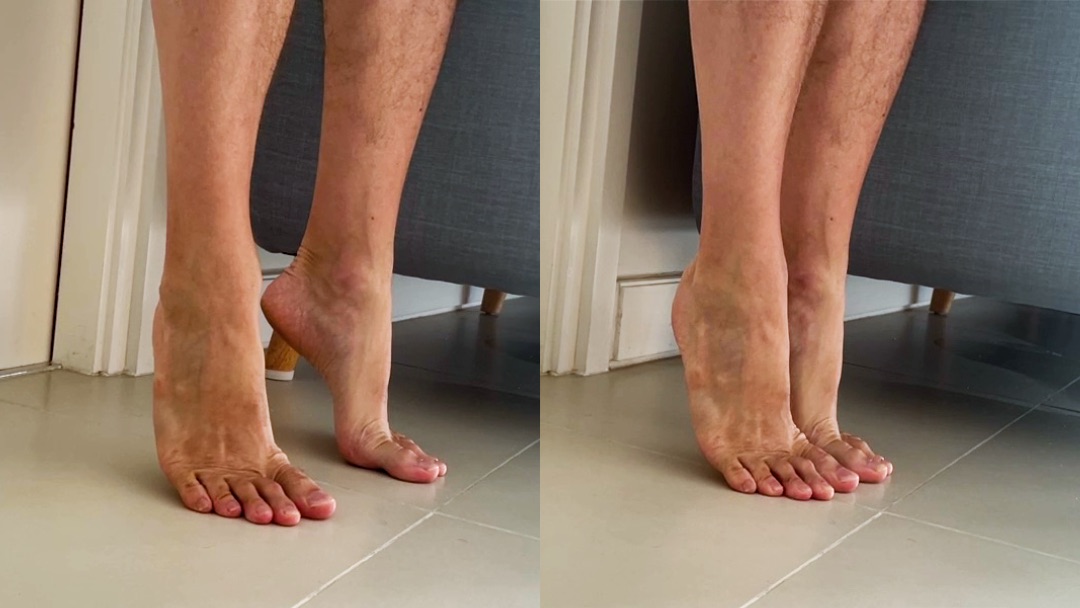
Stand upright with straight legs, with your feet flat on the floor. For better balance hold the back of a chair or place your hands on a wall.
Heel raises
Lift your heels and stand on your toe's base joints.
- Variation 1) Lean more into the direction of one toe when lifting up, go through all toes: right foot 1st, 2nd, 3rd, 4th, 5th and back again, left foot 1st, 2nd, 3rd, 4th, 5th and back again.
Variation 2) Change the starting position: stand feet close together or further apart.
Heel raises
Lift your heels and stand on your toe's base joints.
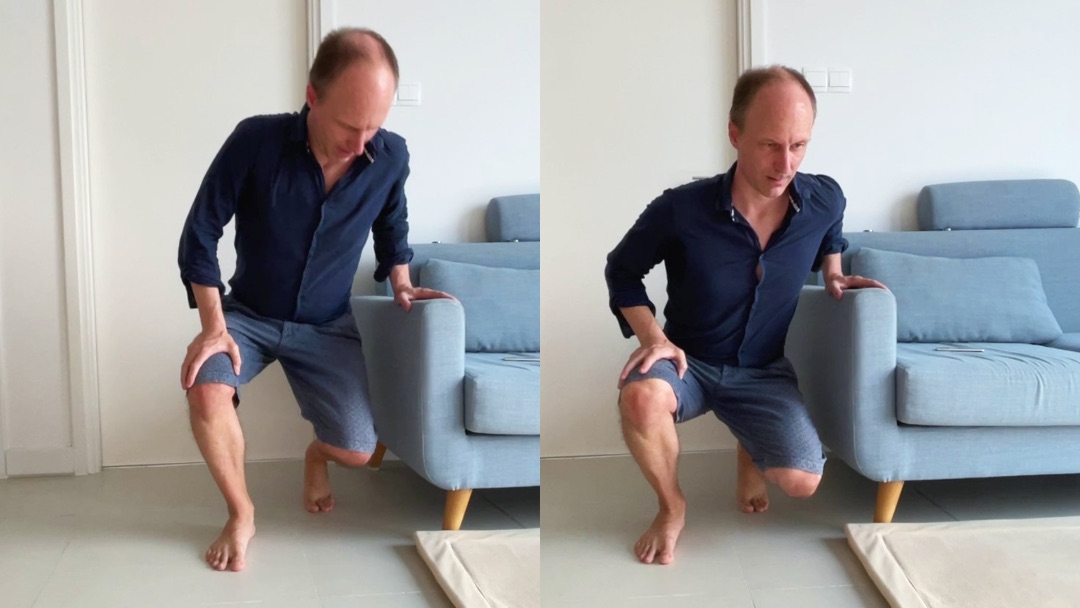
Stand approximately shoulder width apart, your left foot a bit behind you, and your right foot a bit out in front and to the right. Lean with your right hand on your right knee, and with the left hand, for example, on a chair, to support yourself.
Kneel downs, assisted
Bend both knees. Bend your left knee more, let its toes bend, its heel leave the floor, bring it down and forwards, towards the floor.
- Only bend as far as it is still comfortable.
Don't force your knee down all the way to the floor at once.
Drive both your knees forwards. However, your back foot's toes bend, your front foot keeps standing flat on the floor.
Kneel downs, assisted
Bend both knees. Bend your left knee more, let its toes bend, its heel leave the floor, bring it down and forwards, towards the floor.
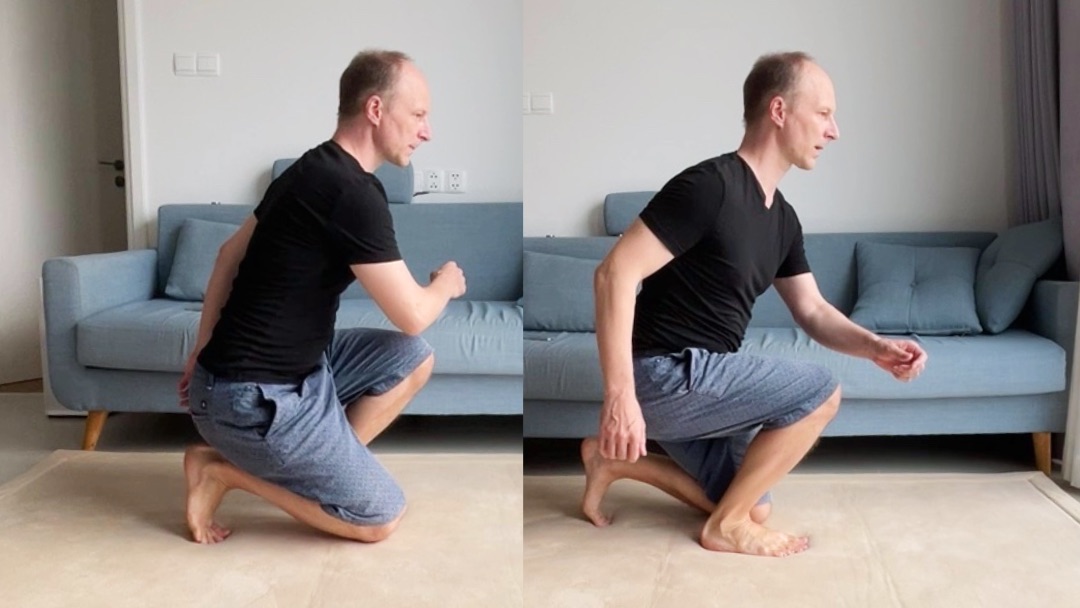
Stand approximately shoulder width apart, with one foot slightly behind you, and the other foot slightly a bit out in front and to the side, its heel approximately a foot's length away from your back foot's toes.
Kneel downs
Touch one knee to the floor in front of you, then take a step backwards and repeat with the other knee.
- The same motion as with the assisted asymmetric kneel downs, but this time without helping with your hands. Alternate between left foot in front and right foot in front.
It's like a bio-mechanically well executed lunge.
Variation 1) Do several kneel downs with one knee before taking a step back and kneeling down with the other knee.
Kneel downs
Touch one knee to the floor in front of you, then take a step backwards and repeat with the other knee.

Stand approximately shoulder width apart, with one foot slightly behind you, and the other foot slightly a bit out in front and to the side, its heel approximately a foot's length away from your back foot's toes.
Kneel downs, loaded
Hold a big water bottle or some weights to do the kneel-downs.
- Make the exercise harder by adding some load, rather than looking for mechanically bad alignment.
Strive for bio-mechanical optimization, acknowledge and nurture the wisdom of your body, of your nervous system, rather than working against it.
Kneel downs, loaded
Hold a big water bottle or some weights to do the kneel-downs.

Supine, lying on your back with both legs extended.
Gluteal squeezes, supine
Squeeze both buttocks, feel your pelvis be raised a little bit due to the hardened up gluteal muscles.
- Variation 1) Squeeze one buttock at a time, compare to the other.
Variation 2) Change tempo on squeeze and on release, fast or slow.
Variation 3) Squeeze both buttocks at the same time.
Variation 4) Change in starting position: press your legs together or have them apart.
Gluteal squeezes, supine
Squeeze both buttocks, feel your pelvis be raised a little bit due to the hardened up gluteal muscles.

Supine, lying on your back with one leg extended, one leg bend and its foot standing. Have your elbows bent and close to your torso, your lower arms standing like candles.
Gluteal squeezes, bridges
Squeeze one or both buttocks and feel your pelvis be lifted up towards the ceiling, to form a bridge that spans from your feet to your shoulders.
- Variation: Keep one leg straight, or bend both legs and stand both feet.
Assistance: Help with your elbows, press your elbows against the floor to engage your upper back, and help your pelvis lift.
Gluteal squeezes, bridges
Squeeze one or both buttocks and feel your pelvis be lifted up towards the ceiling, to form a bridge that spans from your feet to your shoulders.

In kneeling on both knees, insteps of the feet flat on the floor (toe nails touching the floor).
Gluteal squeezes, kneeling
Squeeze one buttock, reach with the other-side hand back to your other-side heel.
- Squeezing one buttock extends that side's hip joint and thus turns the pelvis. Allow this to happen and reach for your heel on the other side.
Variation: Stand your toes on their base joints, squeeze both buttocks at the same time, allow your pelvis to drive forwards, and reach for your heels with your hands.
Gluteal squeezes, kneeling
Squeeze one buttock, reach with the other-side hand back to your other-side heel.

Stand with your feet somewhat shoulder width apart.
Roundhouse squats
Squat forwards with your knees approaching the floor in front of you, then come up by moving your pelvis backwards like reaching towards sitting.
- Look at your feet: you will notice that there are no screws or bolts, nothing to nail your feet down to the floor. So allow your feet to move, to slide, to rotate, to twist, to accommodate, the movements of your upper body.
Variation 1) Squat down backwards, like sitting back on a chair, and squat up by driving your knees forwards.
Variation 2) Lean more on one leg than the other.
Roundhouse squats
Squat forwards with your knees approaching the floor in front of you, then come up by moving your pelvis backwards like reaching towards sitting.
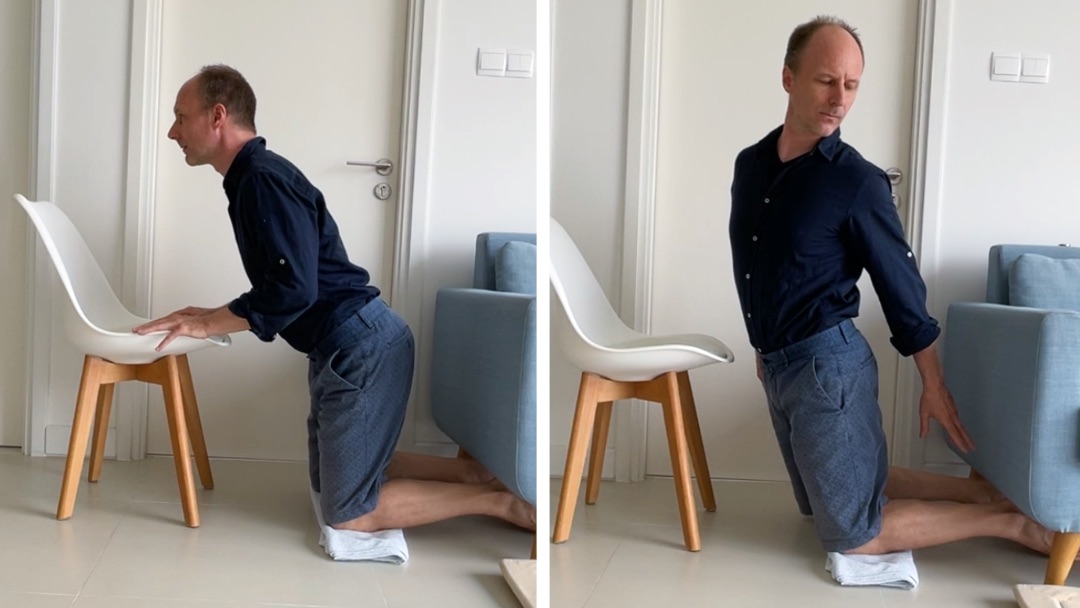
Kneel on both knees, put your feet under something that's heavier than you, for example under your sofa or a large sideboard. Bend your hip joints and lean with your hands on a chair in front of you. Lean forward just far enough so that you can still take off your hands from the chair.
Nordic Curls - hip hinge progression
A hamstring challenge. Drive your pelvis forwards to extend your hip joints.
- Hamstring curls can be performed with gym equipment, Nordic curls with the help of a towel, elastic bands or just some heavy furniture that you can stick your feet under. Nordic curls are a variation of hamstring curls.
Variation 1) Push your left or right hip forwards more than the other, instead of pushing forwards symmetrically. Allow your pelvis and whole self into this turn.
Nordic Curls - hip hinge progression
A hamstring challenge. Drive your pelvis forwards to extend your hip joints.
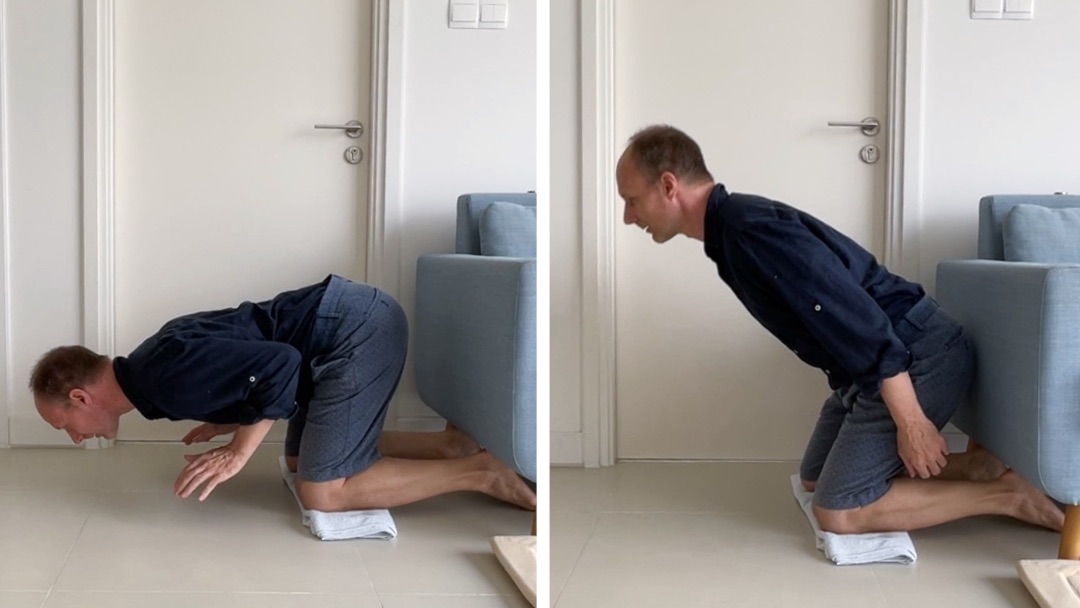
Kneel upright on both knees, put your feet under something that's heavier than you, for example under your sofa or a large sideboard.
Nordic Curls - bow down progression
Bow your head and torso down to the floor by bending in your knees and hip joints.
- The further your reach out forwards with your head, the larger the distance between your feet and your nose when your head arrives at the floor, the harder the exercise.
Take good care not to fall over and hit your head on the floor.
Nordic Curls - bow down progression
Bow your head and torso down to the floor by bending in your knees and hip joints.
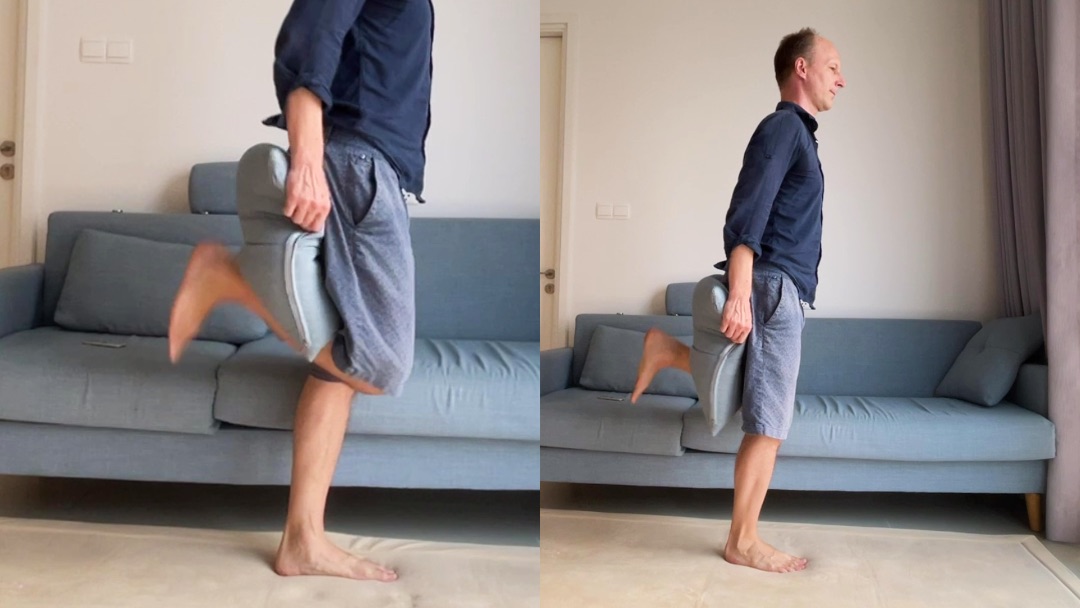
Stand with your feet somewhat shoulder width apart. Hold a big pillow with both hands behind your back, over the back of your knees.
Pillow punches with heels
Explosively bend one leg at a time, kick its heel against the pillow.
- Variation 1) Press your heel strongly against the pillow and hold for a couple of seconds.
Pillow punches with heels
Explosively bend one leg at a time, kick its heel against the pillow.
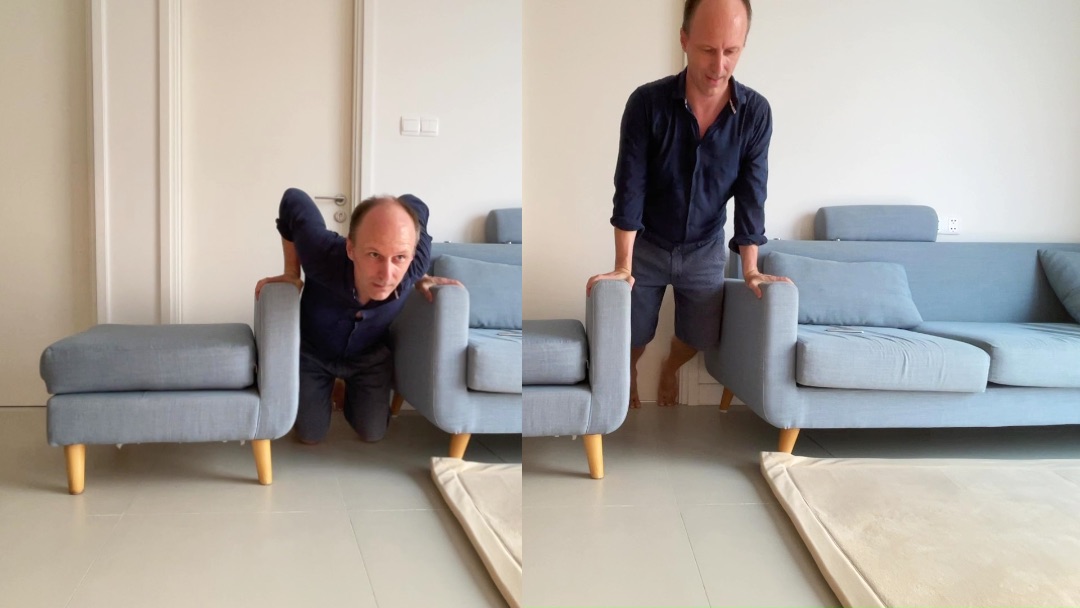
Place each hand on a chair or otherwise elevated surface, with your hands close to your shoulders.
Triceps push-ups
Raise and lower yourself like in a triceps push-up, but on the down-phase let your torso go lower to the floor than your hands.
- Allow your elbows to point to the ceiling, and your spine sink lower towards the floor than your shoulder-blades.
Triceps push-ups
Raise and lower yourself like in a triceps push-up, but on the down-phase let your torso go lower to the floor than your hands.

Stand with your feet somewhat shoulder width apart.
Jumping
Squat down a bit and then jump up a bit. See how far you can jump easily, comfortably.
- Reach out with one arm overhead to touch to a wall or doorframe, to make this a movement that has (or might have) meaning.
Jumping
Squat down a bit and then jump up a bit. See how far you can jump easily, comfortably.
